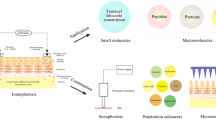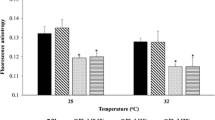Abstract
Purpose. The purpose of this work was to investigate if fatty acids can increase the iontophoretic delivery of midodrine hydrochloride through human dermatomed skin and to observe the effects of iontophoresis and fatty acids on skin using SEM.
Methods. After prehydration for 1 h, human dermatomed skin was treated with 0-0.3 M fatty acids (oleic acid, linoleic acid, decanoic acid, and lauric acid) in propylene glycol (PG) for 1 h. Then the fatty acid solution was replaced by 1% midodrine hydrochloride aqueous solution, and 0.1 mA/cm2 constant current was applied. Samples were taken over 24 h and analyzed by HPLC. After the treatments outlined above, the epidermis was separated, fixed with glutaraldehyde, and dehydrated for SEM.
Results. SEM studies revealed that only 1 h of treatment with fatty acids opened up the tightly compact stratum corneum cell layer, and the permeation study showed a significant increase of the permeability of skin to midodrine hydrochloride after fatty acid treatment.
Conclusions. Using 5% oleic acid pretreatment, with the electrical current offset at 0.1 mA/cm2, the daily delivery of midodrine hydrochloride can provide an adequate clinical application. The enhancement of passive and iontophoretic delivery by fatty acids may be occurring through the same mechanism.
Similar content being viewed by others
References
F. R. Bettley. The influence of soap on the permeability of the epidermis. Br. J. Dermatol. 73:448-454 (1961).
J. C. Tsai, R. H. Guy, C. R. Thornfeldt, W. Gao, K. R. Feingold, and P. M. Elias. Metabolic approaches to enhance transdermal drug delivery. 1. Effect of lipid synthesis inhibitors. J. Pharm. Sci. 85:643-648 (1996).
K. S. Bhatia, S. Gao, T. P. Freeman, and J. Singh. Effect of penetration enhancers and iontophoresis on the ultrastructure and cholecytokinin-8 permeability through porcine skin. J. Pharm. Sci. 86:1011-1015 (1997).
E. Touitou, B. Godin, Y. Karl, S. Bujanover, and Y. Becker. Oleic acid, a skin penetration enhancer, affects Langerhans cells and corneocytes. J Control Release 80:1-7 (2002).
M. Goodman and B. W. Barry. Lipid-protein-partitioning (LPP) theory of skin enhancer activity: finite dose technique. Int. J. Pharm. 57:29-40 (1989).
A. C. Williams and B. W. Barry. Skin absorption enhancers. Crit. Rev. Ther. Drug Carrier Syst. 9:305-353 (1992).
P. W. Stott, A. C. Williams, and B. W. Barry. Mechanistic study into the enhanced transdermal permeation of a model beta-blocker, propranolol, by fatty acids: a melting point depression effect. Int. J. Pharm. 219:161-176 (2001).
E. W. Smith and H. I. Maibach. Percutaneous Penetration Enhancers, CPC Press, Boca Raton, 1995.
N. A. Monteiro-Riviere, A. O. Inman, and J. E. Riviere. Identification of the pathway of iontophoretic drug delivery: light and ultrastructural studies using mercuric chloride in pigs. Pharm. Res. 11:251-256 (1994).
B. S. Grewal, A. Naik, W. J. Irwin, G. Gooris, C. J. de Grauw, H. G. Gerritsen, and J. A. Bouwstra. Transdermal macromolecular delivery: real-time visualization of iontophoretic and chemically enhanced transport using two-photon excitation microscopy. Pharm. Res. 17:788-795 (2000).
S. Mitragotri. Synergistic effect of enhancers for transdermal drug delivery. Pharm. Res. 17:1354-1359 (2000).
J. Y. Fang, T. L. Hwang, Y. B. Huang, and Y. H. Tsai. Transdermal iontophoresis of sodium nonivamide acetate. V. Combined effect of physical enhancement methods. Int. J. Pharm. 235:95-105 (2002).
J. Y. Fang, K. C. Sung, H. H. Lin, and C. L. Fang. Transdermal iontophoretic delivery of enoxacin from various liposome-encapsulated formulations. J Control Release 60:1-10 (1999).
K. S. Bhatia. and J. Singh. Mechanism of transport enhancement of LHRH through porcine epidermis by terpenes and iontophoresis: permeability and lipid extraction studies. Pharm. Res. 15:1857-1862 (1998).
Y. Wang, L. V. Allen, Jr., and L. C. Li. Effect of sodium dodecyl sulfate on iontophoresis of hydrocortisone across hairless mouse skin. Pharm. Dev. Technol. 5:533-542 (2000).
S. Chesnoy, D. Durand, J. Doucet, and G. Couarraze. Structural parameters involved in the permeation of propranolol HCl by iontophoresis and enhancers. J Control Release 58:163-175 (1999).
E. H. Choi, S. H. Lee, S. K. Ahn, and S. M. Hwang. The pretreatment effect of chemical skin penetration enhancers in transdermal drug delivery using iontophoresis. Skin Pharmacol. Appl. Skin Physiol. 12:326-335 (1999).
S. Bolton. Pharmaceutical Statistics: Practical and Clinical Applications, Marcel Dekker, New York, 1990.
S. J. Jiang, S. M. Hwang, E. H. Choi, P. M. Elias, S. K. Ahn, and S. H. Lee. Structural and functional effects of oleic acid and iontophoresis on hairless mouse stratum corneum. J. Invest. Dermatol. 114:64-70 (2000).
S. Y. Oh, S. Y. Jeong, T. G. Park, and J. H. Lee. Enhanced transdermal delivery of AZT (Zidovudine) using iontophoresis and penetration enhancer. J Control Release 51:161-168 (1998).
Author information
Authors and Affiliations
Corresponding author
Rights and permissions
About this article
Cite this article
Wang, Y., Fan, Q., Song, Y. et al. Effects of Fatty Acids and Iontophoresis on the Delivery of Midodrine Hydrochloride and the Structure of Human Skin. Pharm Res 20, 1612–1618 (2003). https://doi.org/10.1023/A:1026139418487
Issue Date:
DOI: https://doi.org/10.1023/A:1026139418487




